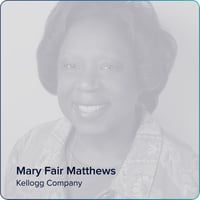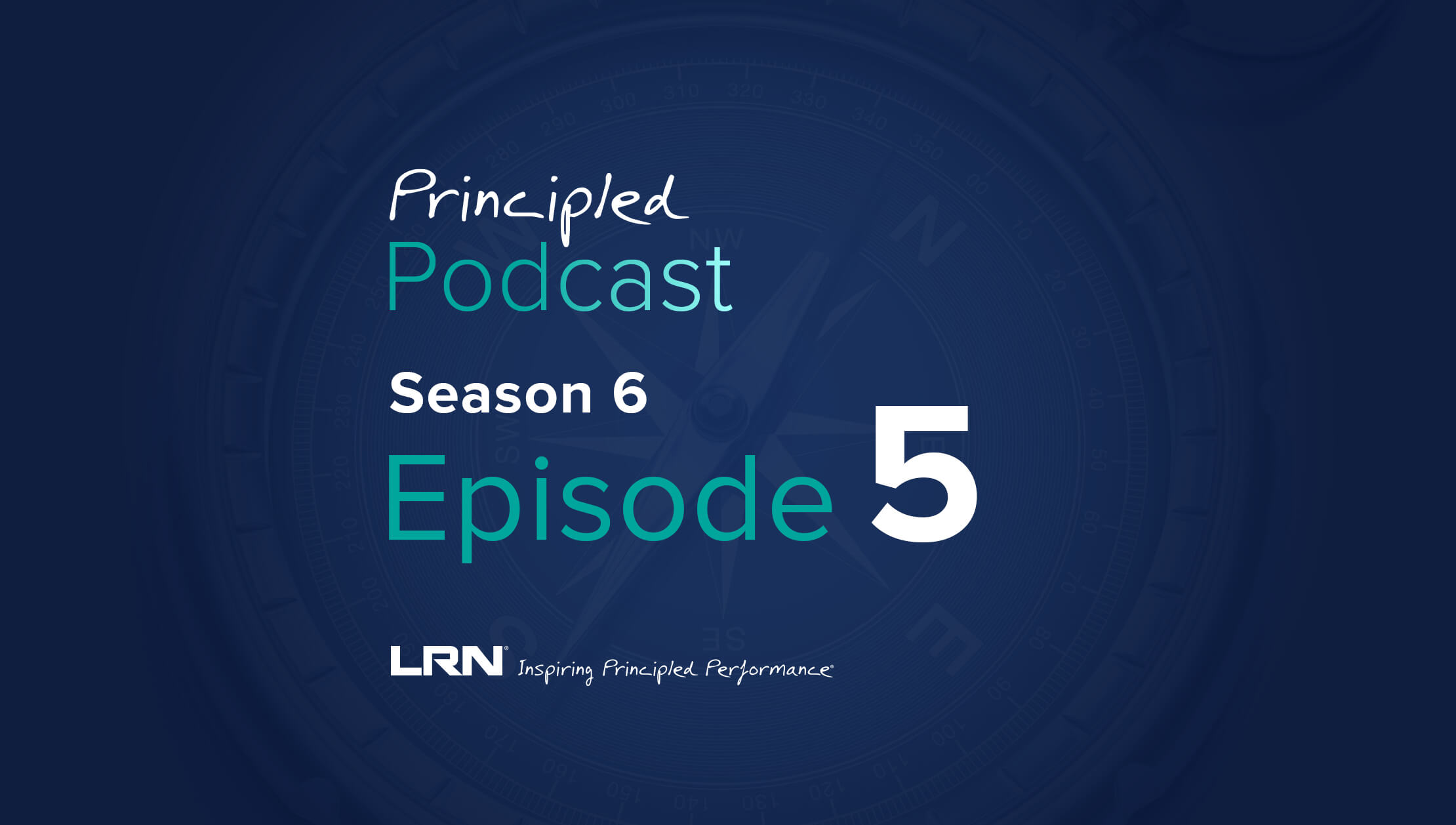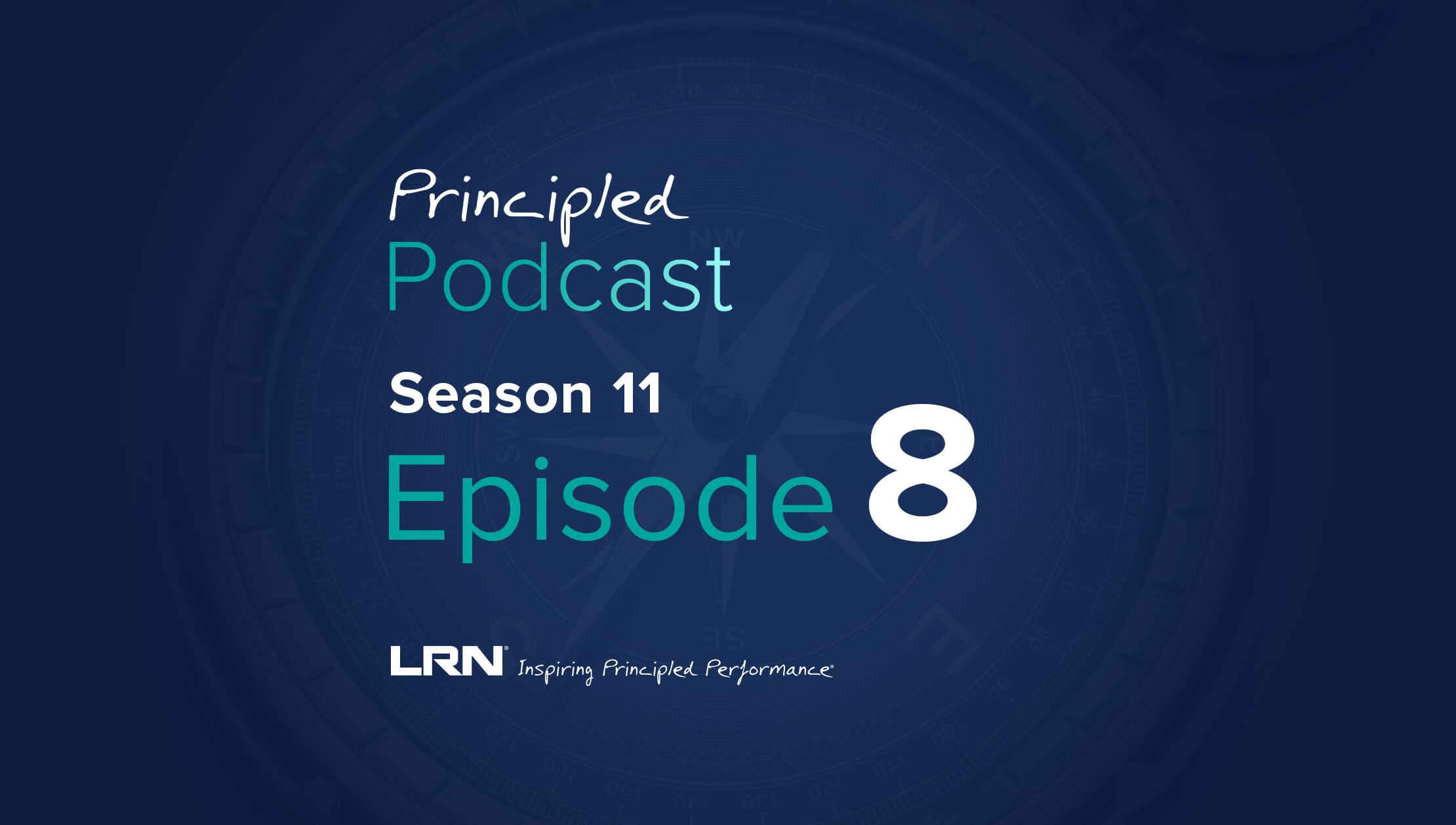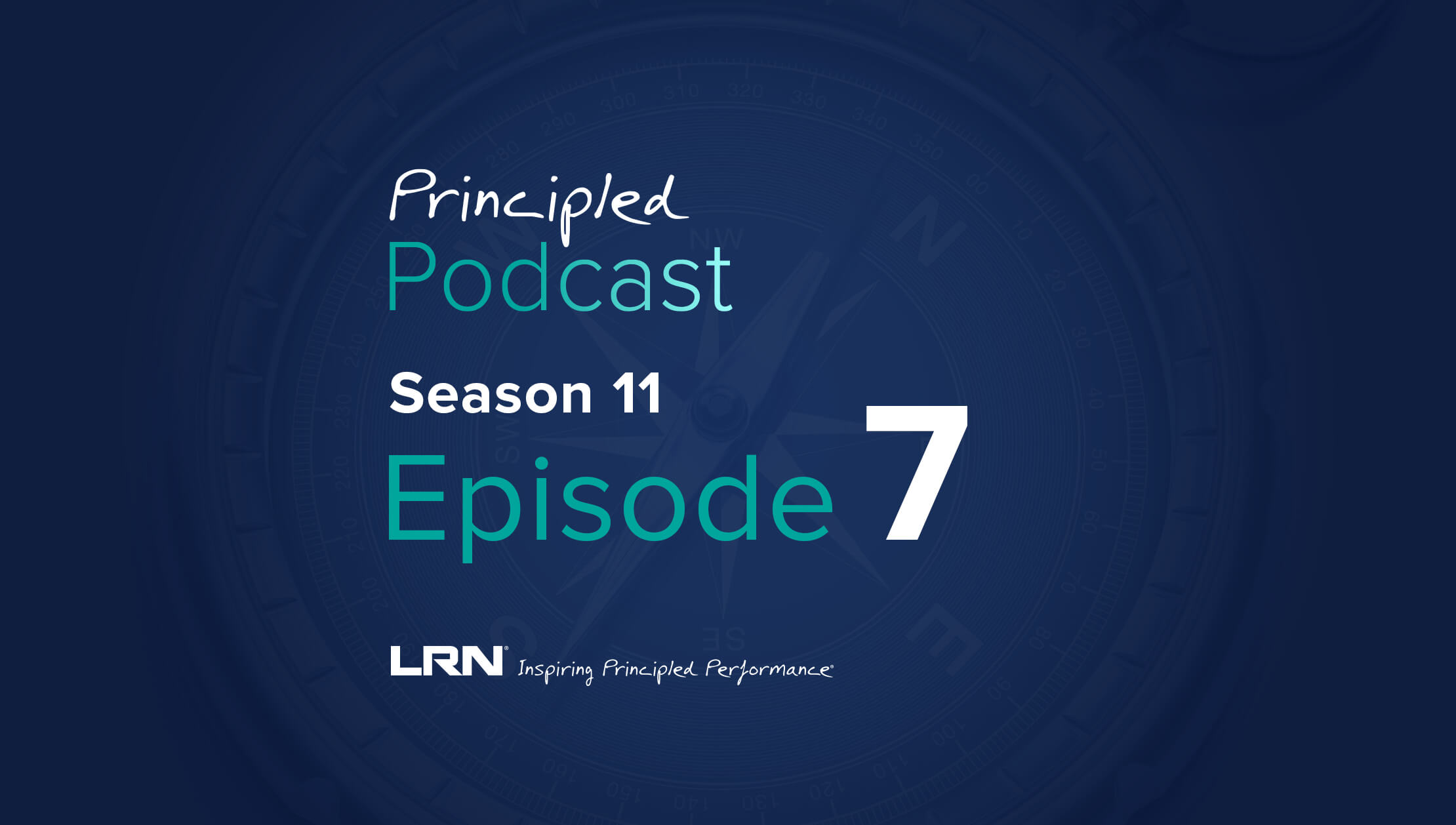What you'll learn on this podcast episode
Gone are the days of writing codes of conduct with pages of unreadable text, legalistic language, and corporate jargon. Today, codes are being designed visually and verbally to better develop ethical, values-based cultures. But how do you transform your code into a useful tool that helps people do the right thing? In this episode of LRN’s Principled Podcast, Senior E&C Advisor Jim Walton talks about how to create a code of conduct that inspires ethical behavior with Mary Fair-Matthews, Senior Corporate Counsel and experienced E&C expert at Kellogg Company. Listen in as the two discuss how Kellogg reinvented their code to further deepen their commitment to ethical conduct through a combination of reimagining code structure, developing a mobile app, and administering training.
Learn more about Kellogg Company's ethics and compliance program here.
Principled Podcast shownotes
- [1:14] Jim introduces our host this week, Mary Fair-Matthews.
- [2:05] What is it that prompted Kellogg to review their code of conduct?
- [4:58] How was the language in the code of conduct updated?
- [7:15] Who were some of the stakeholders involved in the creation of the code of conduct?
- [10:56] What challenges were present in getting the code of conduct into a mobile app?
- [18:10] Why is it important that Kellogg is named one of the world’s most ethical companies?
- [19:32] What advice does Mary have for companies who want to update their code of conduct?
Where to stream
Be sure to subscribe to the Principled Podcast wherever you get your podcasts.
Guest: Mary Fair-Matthews

Mary Fair-Matthews has been with Kellogg’s Labor and Employment (“People”) team since June 2005. She has served in several capacities including providing legal advice and counsel in HR-related matters, managing employment litigation and EEO cases, and supporting the Ethics and Compliance function.
In 2017, Mary began leading the global Ethics and Compliance function with the goal of continuing the legacy of driving a strategic vision for compliance. Mary reviews, evaluates, communicates, and manages compliance concerns and policies. She also implements best practices in training and communication. Mary manages the global investigation function which is made up of a team of investigators around the world who are dedicated to maintaining confidential reporting mechanisms and a consistent investigation process to resolve employee concerns.
Host: Jim Walton

Jim Walton is a member of LRN’s Ethics & Compliance Advisory Services Team – with over 25 years of professional experience in corporate, institutional and government settings, spanning the fields of ethics and compliance; environment, health and safety; and energy management.
Since 2002, Jim has been passionately dedicated to corporate ethics and compliance – designing, developing, implementing and enhancing constantly-evolving, comprehensive, best-in-class, global ethics and compliance programs. Jim has extensive experience in writing, producing and communicating codes of conduct and corporate policies; designing, managing and implementing ethics & compliance risk assessments; implementing anti-compliance and bribery initiatives; conducting third party due diligence reviews; and helping managers at all levels become better ethical leaders.
Jim is a Certified Compliance and Ethics Professional.
Principled Podcast transcription
Intro: Welcome to The Principled Podcast, brought to you by LRN. The Principled Podcast brings together the collective wisdom on ethics, business and compliance, transformative stories of leadership, and inspiring workplace culture. Listen in to discover valuable strategies from our community of business leaders and workplace change makers.
Jim Walton: The days of writing codes of conduct with pages of unreadable text heavy in legalese and corporate jargon are thankfully behind us. Today, codes of conduct are being written and designed to inspire principled performance, guide ethical behavior, and enable a culture based on values and not just rules. But how do you transform your code from a rule book to a useful guidebook that helps people do the right thing? How do you bring it to life for the people who make up your organization?
Hello, and welcome to another episode of LRN's Principled Podcast. I'm your host, Jim Walton, senior ethics and compliance advisor at LRN. Today, I'm joined by Mary Fair-Matthews, senior corporate council at the Kellogg Company. We're going to be talking about how Kellogg reinvented their code of conduct to further deepen their commitment to ethical conduct. The process included completely re-imagining their code of conduct, creating a mobile app to help communicate the code, and deploying training on the key principles and topics covered by the code. As a result, Kellogg's code transformation sparked a renewed sense of how to act on Kellogg's shared values. Mary, thanks so much for joining us today on The Principled Podcast.
Mary Fair-Matthews: Thank you for having me, Jim.
Jim Walton: So why don't we start with just going back to the beginning. What was it that initially prompted Kellogg to begin the process of reimagining your code of conduct?
Mary Fair-Matthews: We normally review our code yearly for small changes, but every five years, we look to do a larger update. And when we started our 2020 update, we took it as an opportunity, as you said, to reimagine our code. Kellogg celebrates 115 years as a company, and we have such iconic brands, and such a rich history, and we have the characters to bring our code to life with such vibrant colors. And we wanted to make sure that all of those elements that make us proud to work for Kellogg came through in the code.
So we started to talk about what type of themes did we want to use, and it was a no brainer that the visuals had to reflect our food. We also wanted to highlight that we're a global company with a presence in over 180 countries. And we wanted to highlight the diverse nature of our employee base, and all the different cultures that we share, and so you see those visuals in the code. And finally, we wanted the richness of the colors to make it appealing to the eye, and those were really important to us as well.
Jim Walton: I have to say, looking at the code, it really jumps out to me that experiencing Kellogg, and all those iconic brands, and colors, and products that we're also familiar with, so that really does come out, really did a great job with that. I'm curious about the reaction of the employees when they saw the code, and kind of its new form.
Mary Fair-Matthews: The employees love it. I received a message shortly after we rolled out the code from a former VP of audit, who, as you can imagine, worked with us closely in the years prior on our code. And he talked about how he loved the transformation of the code, how he loved the visuals and the colors. So we got some input from an expert in our company, who was really knowledgeable of the code. Employees also love it's short in nature, but packed full of details. So we've gotten a lot of great feedback. And usually what we do when we're talking to our employees is we direct them to that provision in the code, so that next time they know where to find it. So it's been really a good experience for the employees as well.
Jim Walton: I really love that. I remember when I was in-house, it was really hard to get people to refer back to the code of conduct. And it's something that we all had struggled with. How do we get people to utilize it? So I'm really glad to hear that people are doing that. What about the language itself, the content of the code, how did you go from... In the past codes were written very difficult to understand, lots of words, lots of legal jargon. If you could talk about that aspect of the code, the actual, the text, and the content, and the writing?
Mary Fair-Matthews: One, we wanted it to be easy to read and easy to understand. We wanted to take concepts that were perhaps difficult to individuals who weren't accustomed to that topic, and make it very easy for them to understand. So really making sure that expectations were well defined, so employees understand what's being asked of them. And then we took those, we provided scenarios and examples of conduct to make sure employees have clarity, the clarity that they need. And then last, we wanted to make sure that they knew where they could ask a question. The dialogue is really important. We want employees to trust us enough to bring their questions and their concerns to us, even if it's in the form of how we can make it better, or just questions along the line about what was intended.
We don't want them to have to figure out things, and we often say, "You don't have to have all the facts before you come to us. You may never have all the facts. We want you to bring your questions and concern to us, and have that dialogue between us. It's not intended to be a monologue." So the idea that it was really easy to read, and visually easy to digest, and understand was important.
Jim Walton: And how many languages is the code available in today?
Mary Fair-Matthews: Today it's available in 16 languages. We added two additional languages in 2020, and so we're really committed to making sure that our employees have access to materials in their own language.
Jim Walton: Are you finding that they're actually doing that in the other languages, or are they just falling back on the English version?
M ary Fair-Matthews: No, we have what we call people [warriors 00:06:37] all around the world in different regions, and we stay in close contact with them to make sure that we're providing the languages that are needed. So we're not falling back on English only, where an employee has a preference, that's absolutely great, but we want to make sure that they do have it in their own language, because as you know, not everything translates in the same way. So I think the employees are using the different languages.
Jim Walton: I always say, "It takes a village to create a good code of conduct." I'm curious about your stakeholders, who did you bring into the process, and how did you get them involved in the creation of the code?
Mary Fair-Matthews: Well, as you know, stakeholders are key. They're experts in areas where we are not, and so we have to work together to integrate the program into everyone's day to day. So the partnership is key. So we partner with the audit teams, the IT team in particular, just all across procurement, all across the organization to make sure that we're putting together provisions of the code that really represents what's happening within the organization. And so what we did is we would send over our old versions of the code with the mock up of what we thought were good, proposed changes. We would make suggestions regarding scenarios covering the topic or their area of expertise, and then we shared what we were seeing from an incident data management perspective. And then we asked for their inputs and their suggestions, so they actually had an opportunity to write their own sections.
So for example, our IT team thought it would be a great idea to put some dos and don'ts into the code to make it easier for employees, and so we did that. And so we continue to leverage our stakeholders today. While ethics and compliance maintains the investigative function, we recognize it in areas like food safety, accounting irregularities, environmental health and safety, that we really need their expertise to make certain that we are thorough, and we're appropriate in our investigation. And so that type of collaboration that occurred during the code refresh continues in our day to day work together. We ask them to bring to us their changes, so that we make sure that employees have relevant and up to date information at all times.
Jim Walton: I'm wondering if it was a bit of a challenge in some cases to get the lawyers and the subject matter experts to all kind of buy into the... One of the things I really love about the Kellogg code is the plain language that it's written in. And I can imagine that some of the subject matter experts and lawyers might have been wondering if there was enough meat to the bones. What was that process like in terms of getting people to kind of be on the same page in terms of getting that language into that plain language that everybody could understand?
Mary Fair-Matthews: As you can imagine, the stakeholders are really interested in getting in their technical language in their area of expertise, so that we have to strike a balance in that area. We want employees to really understand what we expect of them, and so it's important that we're concise, and that we're really clear. And so what we've elected to do is do a two step. The first part of any policy or co-provision really has to clearly lay out the definition of a particular area, and then second, help employees understand how that applies to them. And then lastly, any additional information that you might have for managers, or technical pieces of that code provision, or that topical area is laid out in an appendix.
So what that allows is for employees to get really to the heart of the issue and the policy in a timely manner, because as you can understand, we're constantly competing for time in an employee's day, where they're really busy, and trying to get their information, get their work done. So we want to make sure that information is readily available to them, and allow them to get in and get out. So it's a balancing act for both our stakeholders and for the ethics and compliance department.
Jim Walton: So speaking of getting the information to the employees, information that they need and can use, let's talk about the digital component of the code, and that's the mobile app. What opportunities or challenges did you face in getting your code into that format and rolling it out?
Mary Fair-Matthews: We were really excited about the prospect of having a mobile app, given that now with over 50% of the workforce are millennials, in addition to gen Z. We knew that in order to get their attention, that a mobile app was just really basic. We knew that the equipment that they hold in their hand every day is their preferred way of interacting, so we had to challenge ourselves a lot, and we had to take a look at our own preferred ways of working, and really had to apply a different lens to the material and the design. Simplicity was key. Simplicity is one of Kellogg's values, and we strive for simplicity in how we deal with people, and issues, and improving our process, and procedures, and our activities. So as you can imagine, simplicity was key in this as well.
So we went into it, and it was really an iterative and collaborative process. We shared, and we supported one another. We had a lot of pilots. We would send things over to our employees, and we would get their feedback regarding that. We didn't know sometimes what we didn't know, but we were really committed to learning, and we had a sense of what we wanted. And the LRN team was hugely supportive, and they made themselves available for questions, and they walked through the process with us, sometimes more than once, but it was the commitment I think that was common to the entire team, to be innovative, to learn from our mistakes, to roll out the best product that we could for our employee base, and we're still doing that.
We're still learning, and we're still tweaking, and we're still meeting on a constant basis to make sure that we're continuing to evolve, and that the content is fresh, and that employees are engaged in the mobile app. It just makes it so much easier to access your training and find information. And you don't have to be sitting at your desk to do that. And it's been I think a huge hit with the employees. And we also have other functions of the business that looks to leverage our mobile app as a way to share information as well.
Jim Walton: And I absolutely love the app. I downloaded it myself, and I look at it often, and I share it with other people, and everyone that sees it is really impressed, so you should be really proud of it. Just wondering what kind of the utilization of it do you feel like people are using it? Is that growing, and how do you kind of sustain that? I know there may be a lot of excitement in the beginning, and then maybe that might wane a little bit. How have you been able to keep people engaged with the app?
Mary Fair-Matthews: Yeah. And I think we'll readily admit it is a challenge, and as we think about apps in other contexts, content is continuously refreshed, right? If you go to your app today, you want to see some material, you want to be able to refer back to that, but you also want to get updated materials. So what that requires is that we keep a cadence of materials, uploading that on a weekly, biweekly, and monthly basis, so that employees have a reason to come back to our mobile app. So one of the things we did is we had a number of videos that we rolled out, and we set them up in a way that we could segment them as... We ran it as a full video, and then we broke it up into three videos, where specific questions were being answered.
So that gave us an opportunity to provide a one minute video for someone who was looking to answer a specific question, versus having to sit through perhaps a five minute video. So we're trying to be creative with the content that we have, using our microcards, as I said, communications that may be rolled out in other platforms within the company, but may be conducive to being rolled out in the mobile app. So we're constantly looking for content in different ways that we can use the mobile app, because we have to keep our audience coming back for more.
Jim Walton: So let's talk a little bit about training on the code. As we know, it's important to roll out the code, to get it and to communicate it, but we also need to train people on it. So can you talk a little bit about how you do that at Kellogg?
Mary Fair-Matthews: Well, what we did this year is we rolled out the code in Q1, wanted to make sure that we got a module out there for people to go through links to the code. We also updated the poster, and as I indicated earlier, we also recorded a number of videos. One, we did it with a audit committee chair, because we thought it was important for employees to hear that the board is actively involved and aware of what's going on within the company. Then the second video we rolled out was of the CEO, and our vice chair, and general council to really set the tone for leaders within the organization and managers within the organization. Then the next step was to have an internet article using a real live scenario that perhaps some of the employees recall, to apply some of the code provisions that we were talking about in the module, and actually in the code of conduct handbook. And so those were the first steps that we took.
Since that time, we're in the midst of a 16 month cadence of communications regarding provisions of the code. And so what we're doing in a month by month communication is highlighting provisions of the code. And so we like to think about it as bringing the code to life, and so for those individuals who aren't going to go to the code, because we know we always have those individuals who won't do that, they're going to get in their email a one page or informal overview of a topic. So our first topic that went out in August was how do I find out? So when I have questions about a particular concept or topic, how do I find information regarding that?
And so what we did in that communication was laid out how to reach out to the ethics and compliance office, the numerous ways that you can do that. In September and October of this year, we always roll out our business conduct questionnaire. So we'll send out a communication in advance of that talking about how important the business questionnaires are, why they're important to the organization, how to go in and refresh your business conduct questionnaire, or update it if you need to. So we view the rollout and the subsequent training as just a continuous process throughout the year and into the next year to make sure employees really understand, know where to find, and information that they can even share with others. So that's what we do.
Jim Walton: I have to say that I'm really impressed with the amount of care and proactivity that you and the team take at Kellogg in terms of really wanting to get this information to people in a way that's usable and understandable for them. And really the way that you have your cadence of communications I think is really best in class. And so it's no surprise to me that year after year Kellogg company is named as one of the world's most ethical companies by Ethisphere Institute. And I'm sure that's something that you're all very proud of.
Mary Fair-Matthews: We are really proud of that. And every year it's a personal challenge to us, right? We want to continue to be on that list. We want to make sure that we're implementing leading practices, that we are kind of the best we can be. One of the things we know that if we're going to get our ethics and compliance program right, we have to get our culture right. And that really starts with building trust within the employee base. That's really important to us. So we try to make sure that, again, if you're reporting a concern that employees understand what that next step is going to be, that they understand the investigative process that we keep in contact with them throughout the process of an investigation, and that we share the outcome with them as well.
In our incident management system, we have a comment section. So when we receive a complaint, an employee automatically gets a message saying, "We received it. Thank you for sharing with us. We'll be back to you." And through out that process, we can continue to upload comments for them, so they know where we are in the process. So we're really working hard to build our trust with our employee base, so that they are comfortable sharing with us those things that we need to know, to ensure that we can continue to make our company better.
Jim Walton: So, Mary, what advice would you give to someone who might be listening that's thinking about reevaluating and updating their code of conduct? What are some pointers that you might give based on your experience?
Mary Fair-Matthews: Well, Codes provide a lot of information to your workforce, but you want to make sure that it's a document that they can understand. And you also want to understand the risks that are particular to your organization, and make sure that you're providing clarity around those particular risks. Look for ways to highlight those areas so employees keep that information in mind. You want to make sure that they have really good recall in terms of when you're thinking of an issue or a concern, you want it to come up in the back of their head. I remember some information regarding that. So identifying the risk I think for employees is the biggest challenge.
So while everything is important, not everything has an equal level of importance. So the risk for your company in particular are where you want to highlight. And then there are some things that will fall a little lower down the totem pole, for lack of a better word. You want to communicate with those regarding those things, but they may not be kind of priority. So I think it's really important to understand what your priorities are. And you can do that through your own incident management information that you're able to collect. You can do that through benchmarking, but you want to make sure that the big risks are absolutely covered at the end of the day. And I think that's the number one thing that you want to do with your code.
Jim Walton: Mary, it's been a real pleasure having you on The Principal Podcast. Thank you so much for sharing your experience and expertise with our listeners. I hope you'll come back and speak with us again soon.
Mary Fair-Matthews: Thank you for having me. I enjoyed it, Jim.
Jim Walton: Thank you all for listening. This is Jim Walton, and we'll see you next time on another episode of The Principled Podcast by LRN.
Outro: We hope you enjoyed this episode. The Principled Podcast is brought to you by LRN. At LRN, our mission is to inspire principled performance in global organizations by helping them foster winning, ethical cultures rooted in sustainable values. Please visit us at lrn.com to learn more. And if you enjoyed this episode, subscribe to our podcast on Apple Podcasts, Stitcher, Google Podcasts, or wherever you listen. And don't forget to leave us a review.
Be sure to subscribe to the Principled Podcast wherever you get your podcasts.














